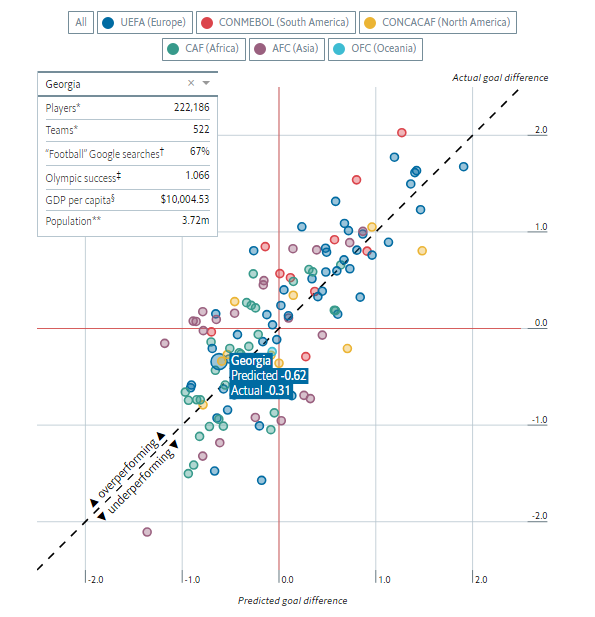Will Georgia Ever Get to the World Cup?
The ISET Economist, a blog about economics in Georgia and the South Caucasus by the International School of Economics at TSU (ISET).
This summer, Russia is again at the epicenter of the world, but this time for hosting the 21st FIFA World Cup football tournament1 and not for the occupation of its neighboring countries’ territories. The majority of the world’s population is gripped by football fever, and Georgians are no exception. You can see random people on the streets wearing the jersey of their favorite nation. Students attend classes wearing jerseys or football T-shirts. Local bars (or pubs) are transformed into fan clubs - flying flags of different nations playing the FIFA World Cup 2018. On social and regular media in Georgia, people are also very active - posting the status of their favorite teams, trolling large football nations (e.g. Germany was one of the most trolled football teams after they lost at the group stage), providing some very funny memes2 and predicting scores.
Whenever the discussions are about football, people stop complaining about government or poverty, and start living the beautiful game. Economists, like all other football fans, are also consumed with the game. But, unlike regular people, they also want to analyze the successes and failures of football nations through the prism of economic science. The question I would like to answer is what makes a country good at football by discovering the underlying factors that determine a country’s football potential. Moreover, I would like to predict whether Georgia has enough economic potential to qualify for the World Cup with its existing resources.
To identify the determinants of a country’s football potential, we should start by analyzing statistical information about the teams that have already managed to qualify for the recent FIFA World Cup. It turns out that the richest country in the competition is Switzerland, with a GDP per capita3 of $63,889 (six times more than Georgian GDP per capita), while the poorest nation is Senegal, with GDP per capita of only $2,566. Moreover, African countries are the poorest nations in the competition and it is notable that none of them managed to progress beyond the group stage of the tournament. However, the majority of Latin American countries with relatively low GDP per capita (less than $20,000) are among the best 16 teams of the competition.
Brazil is the country with the largest population - 208 million4 people - in the World Cup of 2018, while the nation with the smallest population is Iceland, with only 334,252 people (three times less than the population of Tbilisi – the capital of Georgia). Nigeria has the youngest squad in the World Cup,5 while Panama and Costa Rica have the oldest.6 Switzerland, Iceland, Nigeria and Belgium all have just one player who plays club football in his own country, while Senegal and Sweden both have none. England and Russia have the most players from domestic leagues – 23 and 21, respectively. As one can see, there is no clear recipe of socio-economic characteristics that a country can follow to achieve success on the international level. One can, however, make use of statistical models to answer a more fundamental question: what makes a country good at football in the first place?
One such economic model has been built by Simon Kuper and Stefan Szymanski in their book – “Soccernomics.” The authors claim that the size of a nation’s population, its national income, and the country’s experience in international soccer, hugely affects nations’ performance in any international matches. Indeed, the model assesses how well a country should perform, given experience, income, and population. The performance of a country is measured by the average goal difference between teams (e.g. if country plays only two games and wins both of them against its rival by 1:0 and 3:1, the performance indicator will be the average of the two goal differences; e.g., for 1 and 2 goals, 1.5). Therefore, a higher indicator value corresponds to a more successful performance. The database of the model covered all of the official matches from 1872 through 2001 and included 22,130 games.
Later, the Economist used a similar model (with slightly modified determinants) for 126 countries, covering every international game from 1990 through 2018. According to this model, the main determinants of a country’s performance are as follows:
First, the authors of the model included GDP per capita at purchasing power parity to capture the effect of wealth on a country’s success in football. Despite the fact that football has plenty of rags-to-riches stories, people who grow up in extreme poverty face greater obstacles. In Senegal, for instance, coaches have to deworm and feed their players before trainings. Furthermore, poor countries have underdeveloped football infrastructure and only few grass pitches, which prevents youngsters from revealing their talent and become professional football players. According to the authors, holding all other factors constant, having twice the wealth of your opponent is associated with 0.2 goals more than your rival in a head-to-head game. (In support of this claim, it is worth noting that Morocco, Nigeria and Senegal are the only countries participating in the World Cup 2018 that have lower GDP per capita than Georgia).
Second, the authors included the size of the population and the number of football teams and players to capture the effect of a population on a country’s success in football. The number of football teams and players have a positive contribution to a country’s performance in international matches. Moreover, having twice as many players and twice as many teams as your opponent is worth about 0.2 and 0.1 goals more than your rivals. According to the official information provided by the Georgian Football Federation (GFF), Georgia has 522 teams and 222,186 players,7 Iceland and Panama are the only countries participating in the World Cup that have fewer professional players than Georgia. Moreover, Iran is the only World Cup contender with fewer registered football teams than Georgia.
While adding population as an explanatory variable, the authors expected that bigger means better and size contributes to the football performance of the country. Surprisingly, they found that the opposite was true – if countries are similar in every other way, including the number of football players, a country with a larger overall population (less football players per person) generally performs worse, as football is a lower priority sport in such places. Therefore, after controlling for the number of football teams and football players, every 100 million extra people penalizes a country by 0.1 goals per game. It is notable that Uruguay and Iceland are the only participants in the recent World Cup that have a smaller population to Georgia.
Third, the authors included the average rate at which people searched football on Google between 2004 and 2018, relative to other team sports (such as rugby, sumo, basketball etc.), to capture the effect of relative interest in football (popularity of this sport). Football got 90% of Africa’s attention, 20% in America, and only 10% in South Asia. Iran, Nigeria, Tunisia and Senegal have the highest percentages (above 90%), while Saudi Arabia, Australia, Japan and South Korea the lowest (below 40%) among the participants of the current World Cup.8 The study showed that ten percentage points more Google interest in football than your opponent was worth 0.1 goals. In Georgia, 67% of Google searches were for football, relative to other types of sports, which further indicates that football dominates other sport activities in the country.
Georgians are keen on watching international football games, despite the fact that the Georgian national team has never succeeded in qualifying for any of the core international tournaments. According to the official statistics of FIFA, more than 24% of the Georgian population watched at least 30 minutes of a football game during the World Cup of 2014 in Brazil, and the total number of hours spent watching football exceeded 210. These numbers are a little bit lower than for Armenia (57% of population), Azerbaijan (36% of population) and one of the World Cup contenders, Iceland (49% of population), but higher than for China, Egypt, Cameroon and India.9
Georgian people very rarely attend Umaglesi Liga10 matches. According to the Thomas Efs database,11 the average attendance for Umaglesi Liga games amounted to only 1,016 people in the 2017 season.12 It is notable that Georgia’s Umaglesi Liga games have an average attendance rate similar to the seventh tier league in England, and this number is 19-20 times less than the average attendance at the Dinamo Tbilisi football matches before the collapse of the Soviet Union.13
Finally, to capture the national enthusiasm of a country, the authors included in the model the number of Olympic medals won per million people. One additional medal gained per million people was worth 0.2 goals, after controlling for other variables. Georgia managed to win 1.066 medals per million in the summer games during the period 1992-2016. It is notable that Australia (2.019) and Denmark (1.507) are the only participants of the recent World Cup that have a higher number of medals gained per million people than Georgia. Moreover, the authors accounted for home advantage, which is worth 0.6 goals per game, and excluded all of the countries that have played in less than 150 international matches since 1990 (e.g. Bhutan and the Cayman Islands).
It is notable that the identified socio-economic determinants explained about 40% of the total variation in average goal differences. If we compare the average goal difference against a team of medium strength, computed by actual data and predicted by the Economist’s model, we will be able to identify overachieving and underachieving countries, given their resources. When the predicted goal difference of a team of medium strength exceeds the actual difference, then that country has underachieved its potential, as based on the given level of GDP per capita, population size, and interest in football, and that country should have a better average goal difference than it actually has. When the predicted goal difference is below the actual one, the country has overachieved its potential. Uruguay, for instance, was among the biggest overachievers, managing to have nearly a goal per game better than expected. Brazil, Argentina, Portugal and Spain were close behind. West African and Balkan countries are overachievers too, while China, India, Luxemburg, Canada, Hungary and particularly Germany, performed much worse than predicted.
Figure 1. Average Goal Differece against Median Team

So, what about Georgia? Georgia scores 0.31 goals less than a team of medium strength; however, according to the actual data, while taking into consideration the wealth, size and interest of the country, Georgia should score 0.62 goals less than the team of medium size. Sadly, the data suggests that Georgia already performs above its very low potential (Georgia overachieves its potential). Therefore, based on the outcome of the economic model, the failure of Georgia’s football team is not about the underemployment of the country’s socio-economic resources for football, but lack of resources themselves (poverty, small population, less experience, and lack of sport interest do not let youngsters reveal their talents).
I want to conclude this blog with an optimistic quote from the book of Simon Kuper and Stefan Szymanski: “… Georgia clearly has potential. The country is small (5 million people), and horribly poor (even today, average income is below $4,000 per year). If Georgians could just become as rich as Croatia, they too could start beating England at Wembley.”
1 This is the first World Cup to be held in Eastern Europe, the eleventh time that it has been held in Europe, and the first time the tournament takes place on two continents – Europe and Asia.
2 “Meme is an image, video, piece of text, etc., typically humorous in nature, that is copied and spread rapidly by Internet users, often with slight variations” – Oxford Dictionary.
3 GDP per capita at PPP, 2016.
4 2016 Data.
5 26 years on average.
6 29.6 year on average.
7 Teams and players of any standard, estimated, 2016.
8 Saudi Arabia, Australia, Switzerland, Sweden, South Korea, Panama, England and Japan were the countries among World Cup participants that have lower percentage of Google interest than Georgia.
9 Source: Television Audience Report of 2014 FIFA World Cup Brazil, FIFA - www.img.fifa.com/image/upload/n3z25ncdjj9qdwja1tet.pdf
10 Umaglesi Liga is the first trier championship for Georgia.
11 Source: www.european-football-statistics.co.uk/attn.htm.
12 FC Torpedo Kutaisi was the most popular team in the first trier league with average attendance of 2 794 people.
13 Wars, political instability and extreme poverty in the early 90s were among the main reasons why people lost interest in football.
By Davit Keshelava











